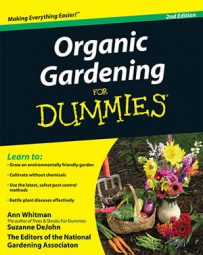Rodents such as squirrels groundhogs, moles, and meadow voles can do a lot of damage to a garden. Even though these small rodents don't eat everything overnight, you need to find a way to keep these pests out of your garden:
Woodchucks: Groundhogs generally stay within about 100 feet of their dens, venturing out morning and evening to find food. They favor beans, squash, and peas, and they can mow down a row of seedlings overnight.
Use these techniques to keep them at bay:
*Fencing: Groundhogs can climb up almost as well as they can dig down, so use a sturdy 4- or 5-foot fence, and bury the bottom 18 inches underground. Bend the top of the fence outward so that a groundhog falls over backward if it attempts to climb over. Two strands of electric fence ¯ one 4 inches above the ground and the other 8 inches high ¯ may also keep them out.
*Repellents: Hot pepper wax sprays may act as deterrents; groundhogs don't seem to be fazed by other repellent sprays.
*Traps: You can use a Havahart trap to capture a live groundhog and then release it into the wild. Groundhogs can't survive in wooded areas.
Groundhogs can carry rabies and are aggressive, so use caution around them.
Gophers: Gophers are difficult to scare or repel. Castor oil sprayed on the garden may work. If gophers are a serious problem, you may want to go to the trouble of lining the sides and bottom of your garden (at a depth of 2 feet) with hardware cloth. Gopher-resistant wire baskets can be placed in planting holes before planting. For persistent problems, use traps.
Voles: Voles create extensive networks of tunnels that, if located under your garden or lawn, can cause root damage. Chewed root vegetables probably are the work of voles. Look for the tiny, 1/8-inch-wide chisel marks left by their incisors.
Voles are hard to control, but you can discourage them by keeping your yard free of weeds and keeping grass mowed. Surround plantings with a fence made of 1/4-inch hardware cloth buried 6 inches deep and rising at least a foot off the ground.
Moles: Moles are carnivores and don't eat plants, but they burrow in search of grubs, earthworms, and other insects.
Squirrels: These agile, fearless creatures can cause quite a problem, especially in newly planted bulb beds. They're also likely to eat fruits, nuts, berries, seedlings, and bark.
You can't get rid of squirrels permanently. You can try deterrents like spraying bad-tasting sprays on favorite plants and protect your bulbs in fall by covering them with chicken wire; the bulbs will grow right through it in spring.
Armadillos: These creatures can climb and burrow, but you may be able to exclude them from your yard with a fence that slants outward and extends 1 foot into the soil and 2 feet aboveground.

